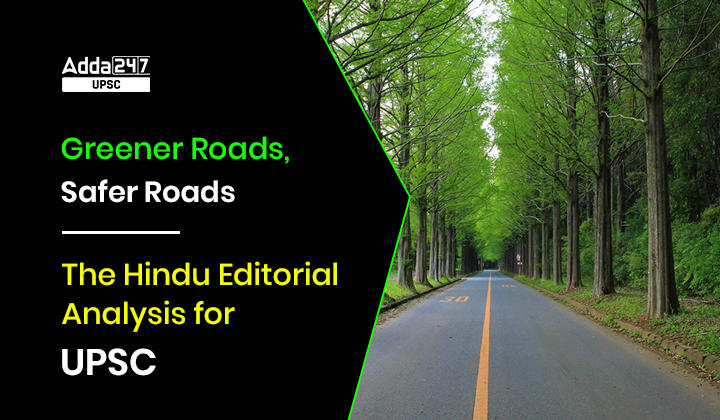Table of Contents
Relevance of ”Greener Roads, Safer Roads” for UPSC
Greener Roads, Safer Roads: Road safety and environmental sustainability are closely intertwined concepts. Being cognisant of the latter while working on the former is the need of the hour. Today’s editorial – Greener Roads, Safer Roads covers:
GS 2: Government Policies & Interventions
GS 3: Infrastructure
How Road Accidents impact environment?
- In 2021, India reported 4,03,116 crashes, each of which adversely impacted the environment in various ways and in different degrees.
- Most vehicles contain toxic metals such as lead, mercury, cadmium or hexavalent chromium, which are detrimental to the environment.
- Fuel and fluid leaks are seen at crash sites.
- Severe road crashes lead to automobile wreckage, which becomes a part of unusable endoflife vehicles. This gives rise to scrappage.
The Editorial Analysis- The Road to Safety
No proper Scrapping!
- India is estimated to have about 22.5 million end of life vehicles by 2025.
- Despite being one of the largest car and light commercial vehicle markets in the world, India’s National Automobile Scrappage Policy, launched in 2021, is still in its nascent stages.
- With the absence of widespread, systematic facilities dedicated to their proper recycling, vehicles after road crashes as well as old end of life automobiles are left to rot by the wayside.
- Some end up at landfills or at informal recycling facilities where rudimentary hand tools are utilised to unscientifically dismantle them.
- This leads to the leakage of hazardous constituents such as oils, coolants and glass wool.
- Vehicle landfills turn into automobile graveyards leading to wasteful and suboptimal land usage and water and soil pollution for decades.
How environment friendly Speeding can limit Road accidents?
- One of the biggest factors for road crashes is speeding. In 2020 alone, speeding was responsible for 91,239 road crash fatalities, comprising 69.3% of all road crash deaths registered.
- Speeding has consistently been responsible for over 60% of all road crash fatalities in India in the last five years.
The case of Europe
Simulation exercises in Europe have demonstrated that cutting motorway speed limits even by 10 km/h can deliver 12% to 18% fuel savings for current technology passenger cars, along with a significant reduction in pollutant emissions, particularly Nitrogen Oxides and particulate matter (PM) output, from diesel vehicles.
The case of Amsterdam
A similar study conducted in Amsterdam demonstrated that where the speed limit was lowered from 100 km/h to 80 km/h, PM reduced by up to 15% thereby significantly improving air quality.
Lancet study on Road Accidents
What should be highway speed limit?
- Studies show that highway speed limits of 96.5 km/h are 25% more efficient than limits of 120 km/h, in which case wind resistance leads to more fuel consumption.
- Consequently, several governments globally have reduced speed limits to prevent crashes and lower air pollution. For instance, the Wales government brought in 80 km/h speed limits at five locations across Wales to reduce outdoor pollution and improve public health.
What is Zero Fatality Corridor solution for road safety in India?
- In India, the Zero Fatality Corridor solution for road safety by the Save LIFE Foundation (SLF) takes environmental sustainability seriously and focuses on reducing speeding through advanced engineering and enforcement technologies.
- All road safety initiatives undertaken and recommended by the SaveLIFE Foundation are designed to be impactful and environment friendly.
Various Green initiatives
- Vegetation on or very close to the road stretches often falls prey to road widening initiatives.
- The Foundation’s ZeroFatality Corridor (ZFC) programme, which was deployed on the MumbaiPune Expressway in 2016, helped bring down road crash fatalities by 52%, as of 2020.
- Similar interventions were introduced in 2018 on the Old MumbaiPune Highway and helped reduce the road crash fatalities on this stretch by 61%, as of 2021.
- Initiatives included guarding natural hard structures such as trees using crash barriers to prevent direct collisions, and installing retro reflective signage on the trees to make them more visible to commuters.
- The Government of India too is now building green corridors to go over forests and animal paths as opposed to going through them.
- Scaling this will have a profound impact on preserving the environment while ensuring better road connectivity.
Nonhazardous material for signage
- Missing or inadequate signages are another leading cause of road crashes. Their absence results in road users being unaware of a stretch’s unique features in a timely manner, which could lead to crashes.
- It is a common standard practice to use asbestos for creating these signages. As asbestos has an adverse impact on the environment, the ZFC programme opts only for longlasting, highquality, nonhazardous material for signage.
- Despite being more expensive than asbestos, one of the most sustainable and recyclable materials, Aluminium Composite Panels, are employed for signages.
- Not only is this free of toxic gas or liquids during the production process, it is also recyclable separately as aluminium and plastic, without much value or quality loss. This also makes it apt for subsequent multipurpose usage.
Conclusion
Roads and the environment are inseparable spaces. They are not just our shared resources but also our joint responsibility. Therefore, safer roads and a sustainable environment can be ensured only through the joint efforts.




 TSPSC Group 1 Question Paper 2024, Downl...
TSPSC Group 1 Question Paper 2024, Downl...
 TSPSC Group 1 Answer key 2024 Out, Downl...
TSPSC Group 1 Answer key 2024 Out, Downl...
 UPSC Prelims 2024 Question Paper, Downlo...
UPSC Prelims 2024 Question Paper, Downlo...
